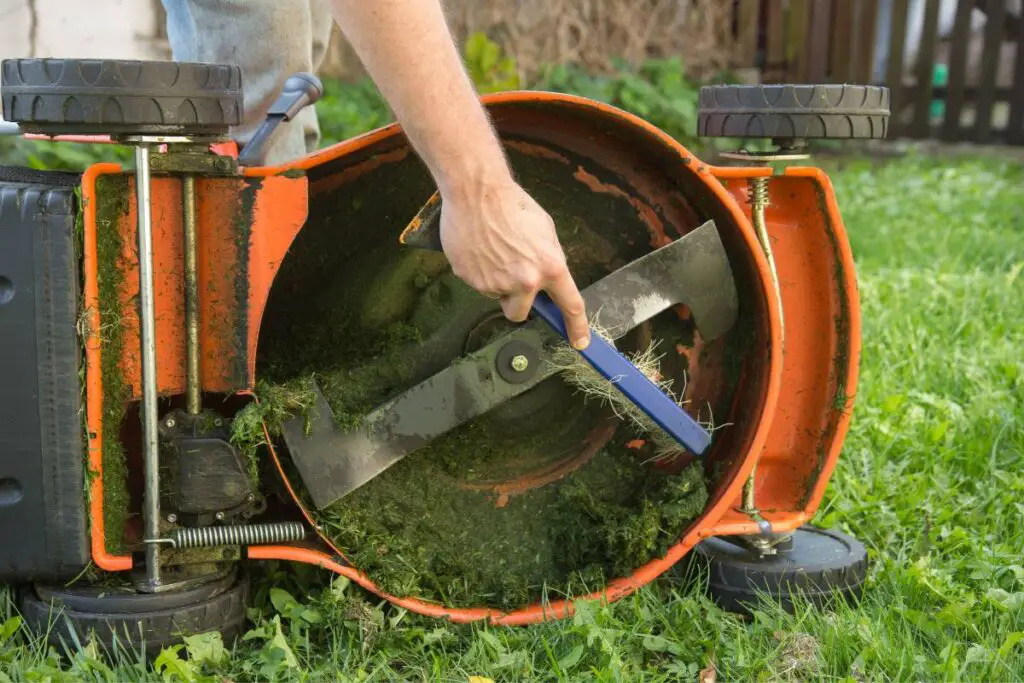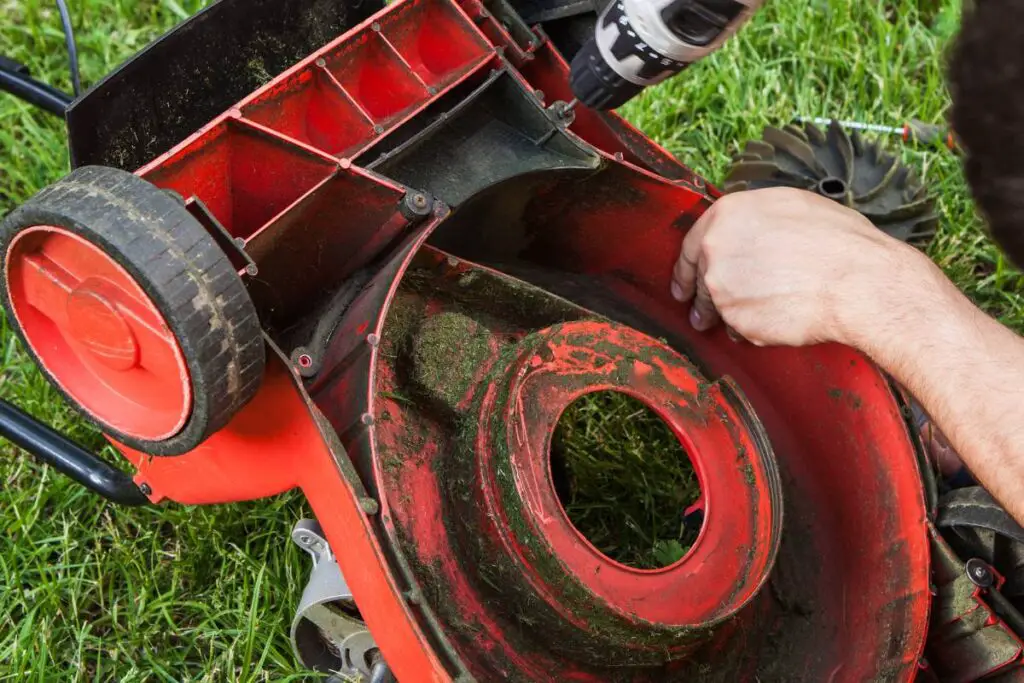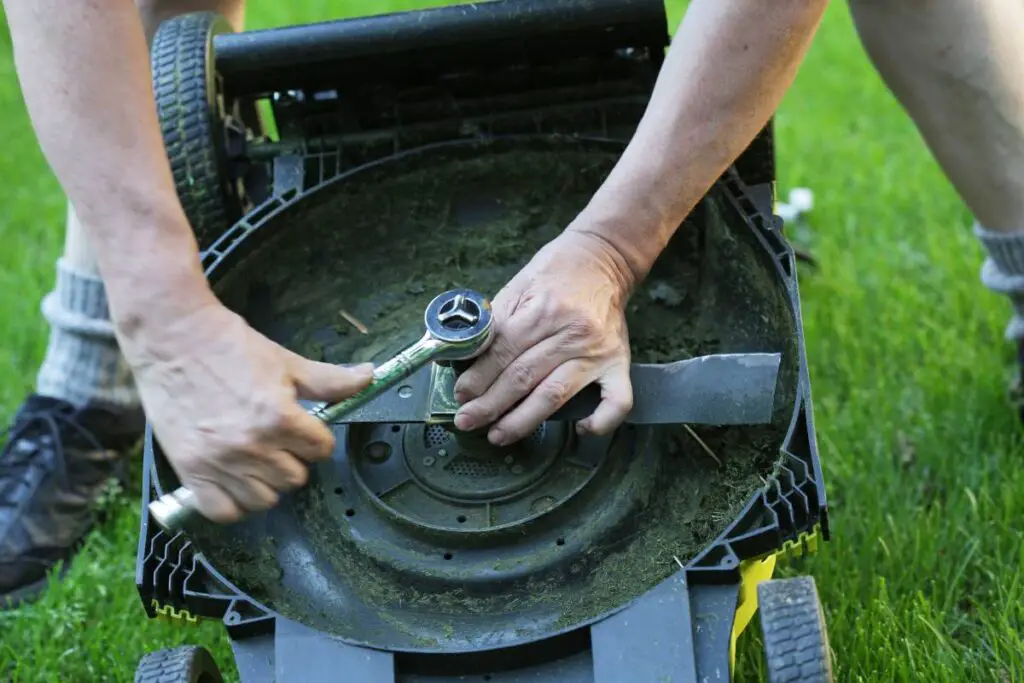Maintaining a sharp blade on your lawnmower is important to keep your grass in the best quality possible. It is quite impossible to cut the grass properly with dull blades because they can tear up the grass abnormally. This can lead to the yellowing of the lawn and can attract various pests and diseases, resulting in an unhealthy lawn.
Generally, it is possible to sharpen the lawnmower blade without removing it using some tools and a little knowledge. Start by grinding the blade at a 45° angle from the center out to the edge of the blade. Make sure you grind equally on both sides of the blade for optimal performance.
This article will discuss in-depth how you can sharpen the lawnmower blade without removing it, along with some mistakes to avoid.

Why is it important to sharpen the lawnmower blade?
Lawnmower blades become dull too quickly compared to other kinds of blades.
These blades don’t need to be extremely sharp to work effectively, but once they become too blunt, they start shredding and tearing the grass instead of cutting it properly.
Once the blade starts tearing the grass, it becomes difficult for them to grow efficiently.
You may even notice that the lawn is turning yellow or brown and have a high chance of getting infections which gives a bad look to the entire lawn.
Maintaining the sharpness of the blade is also good for the lawnmower itself.
Mowing with a dull blade can stress the different working parts of the lawnmower, including the motor, resulting in expensive maintenance requirements.
To keep your lawn and lawnmower in the best possible condition, you must sharpen the blades continuously.
Also read: Is It Better To Sharpen Or Replace Mower Blade?
How to sharpen the lawnmower blade without removing it?
- Gather the needed tools.
- Shut the gas tank.
- In case the lawnmower is electric, detach the power cord.
- Tilt the lawnmower and keep the wooden block or locking pliers on the side of the mower deck.
- Wash the blade with water with the help of a steel brush.
- Use a flat file or angle grinder to sharpen the edge gradually.
- Lower the lawnmower
- Uncover the gas tank.
9 Steps for sharpening lawnmower without removing it
Let’s discuss how you can sharpen the lawnmower blade without removing it.
You may think it’s a complicated process, but it is simple.
Everyone can easily sharpen a mower’s blade with the help of the right tools, so let’s see how it is done.
1. Gather important equipment
Before sharpening lawnmower blades without removing them, let’s discuss the important equipment you need to get the work done.
Tools required are:-
- A grinder, A Rotary sharpening tool, or a flat metal file.
- Safety goggles
- Cut proof gloves
- A De-burring tool
- A wooden block or locking pliers to block the blade
- Water bucket
- Brush and knife to clean the blades
- Lubricant
- A shop rag
Once all the supplies are available, keep your lawnmower on the bench or flat surface to start working on it.
2. Shut the gas tank
First, before sharpening the blades, remove the fuel tank’s lid and cover with a plastic bag on the gas can’s top and seal it properly.
After that, keep the lid in an earlier position.
Sealing the gas tank is necessary to avoid gas or oil leakage while the lawnmower is tilted.
You can also drain the fuel from the gas tank and shut it down.
Looking for gardening supplies? We have tested 100's of products before recommending them to you guys. Check out our best pick below:
| Image | Gardening Supplies | Best Price? |
|---|---|---|
 Top
Top Top
Top | Raised Garden Bed Kit | Check On Amazon |
 | XLUX Soil Moisture Meter, Plant Water Monitor, Soil Hygrometer Sensor for Gardening, Farming, Indoor and Outdoor Plants, No Batteries Required | No Results |
 Top
Top Top
Top | 82 Pcs Garden Tools Set and Extra Succulent Tools Set | Check On Amazon |
 | Joeys Garden Expandable Garden Hose with 8 Function Hose Nozzle, Lightweight Anti-Kink Flexible Garden Hoses, Extra Strength Fabric with Double Latex Core, (50 FT, Black) | No Results |
 Top
Top Top
Top | Dual Chamber Compost Tumbler | Check On Amazon |
 Top
Top Top
Top | Sunnyglade Plant Stakes | Check On Amazon |
 Top
Top Top
Top | Organic Cold Pressed Neem Seed Oil | Check On Amazon |
 Top
Top Top
Top | Mighty Mint Gallon :-Insect and Pest Control Peppermint Oil | Check On Amazon |
 Top
Top Top
Top | Scotts DiseaseEx Lawn Fungicide | Check On Amazon |
 Top
Top Top
Top | Jacks Classic 20-20-20 All Purpose Fertilizer | Check On Amazon |
 Top
Top Top
Top | 30,000 Seeds Pollinator Attracting Wildflower Mixture | Check On Amazon |
 Top
Top Top
Top | Survival Vegetable Seeds Garden Kit-Over 16,000 Seeds | Check On Amazon |
3. Detach the power cord
Before sharpening the lawnmower’s blades, detach the power cord or remove the battery.
Especially for an electric lawnmower, always confirm that you detach the spark plug cable or unplug the power cord.
By doing this, you will avoid a sudden accident. Otherwise, it can start unexpectedly.
4. Tilt the lawnmower over

Keep the lawnmower on a flat surface, then tilt it into its side.
This is one of the important things to do, and ensure you don’t tilt the lawnmower incorrectly.
The right way is where the carburetor will face upwards.
In this way, you can operate the blades easily, and also it will avoid leakage of oil and gas in case you haven’t drained the fuel.
5. Give support to the lawnmower
After you are done with tilting, make sure it stays stable in a particular position so it doesn’t fall accidentally.
Take 2×4 wood pieces and then keep them diagonally against the mower sides.
This provides good support to the entire machine, which will also help you to work on the blades properly.
6. Block the blade movement
After the lawnmower position is secured, keep another block to lock the movement of blades.
Take a wooden block or pair of locking pliers and block them to the side of the mower deck.
Use wood that can easily get fit between the blade and one side of the lawnmower deck.
Or, you can lock the pliers on the edge of the lawnmower deck.
Now the blades will not be able to rotate because they will hit the wooden block or locking pliers.
While sharpening, it is always best that the blade stays in one position and doesn’t rotate.
Otherwise, it will be much more difficult for you to work on the blades.
7. Clean the blade and mower deck
Always clean the blade and the mower deck before grinding or sharpening.
Get rid of every piece of waste on the underside of the lawnmower and the blade.
To remove the rust from the blade, use a steel wire brush and scrape the dried waste and grass.
But if the dirt is stubborn, take a water bucket, brush, and knife to clean all the waste and dirt under the deck and blades.
8. Start grinding or sharpening
After you are done with all the preparation, you should start grinding the blade.
You can use many options for sharpening, such as sickle bar cutters, metal files, electric grinders, drill blades, honing steel, knives, etc.
Use a tool in which you are more comfortable and easily accessible.
There are 3 things you need to do while sharpening:
- Sharpen the blade at a 45° angle: At first, the sharp top side of the blade. The top side means the side that faces the mower engine, not the side that faces the ground. While sharpening, follow a proper 45° angle properly and always go steady and slow.
After sharpening with the top side, maintain the same angle process on the other side.
- Go only in one direction: It is necessary to grind the blade in one direction smoothly. Begin with the back of the blade (the center where it is mounted) and then slowly grind the edge as you shove out towards the end of the blade. Strictly avoid back and forth or sawing motion. Instead of grinding faster, you should always do it slowly for good results.
- Grind the same quantity of material from both sides of the blade: As you grind the blade without removing it, you should sharpen both sides to maintain balance. As it is impossible to know how much material you remove from the sides, you must decide by making assumptions. Remember every pass you attempt from your grinder and sharpen equally according to that.
Always use the file’s or grinder’s full length in every pass.
9. Uncover the gas tank
Once you are done with the sharpening process, lower the lawnmower slowly to the ground. Plug in the power cord or insert the battery.
Then open the fuel tank’s lid, take out the plastic bag and place the lid back.
Common mistakes to avoid while sharpening the mower’s blade without removing it
People often make some common mistakes that we should avoid. Let’s discuss some mistakes to get aware of things you might do.
1. Don’t know whether the blades need to sharpen or replace

Sometimes, people completely replace the blade, where it just needs to be sharpened.
Normally, lawnmower blades need a replacement after 2 to 3 seasons. Otherwise, the blades work fine after sharpening.
But if the blade is completely damaged, like serious rust, bent, or large dents, you may replace it with a new one.
Make sure you know when to replace and sharpen the blades, as it saves a lot of time.
2. Sharpening the blades without emptying the fuel
People often forget to empty the gas tank while sharpening the lawnmower’s blade.
Before sharpening, it is important to drain out the fuel or seal the gas tank.
It is because when you tilt the lawnmower on its side, it helps to prevent fuel leakage.
3. Blocking the blade movement with hands
For sharpening the lawnmower’s blade without removing it, it is important to block the blade movement.
But instead of using wooden blocks or locking pliers, people often use their hands to secure the blade movement.
Holding the blade with one hand and sharpening with the other can be risky, especially when using an angle grinder or a drill.
Also, it won’t be easy to operate at a right angle while using the hands.
4. Sharpening at a faster speed
You should never grind the mower’s blade at a faster speed.
This will not help to sharpen the blades, and there will be a lot of time wastage.
Instead of sharpening too fast, always do it steadily and slowly without any rush for the best results.
5. Ignoring excess vibration
After you have sharpened the blades, always check how your mower is sounding or running.
If your lawnmower is running with excess vibration and weird noises, then it means you must have sharpened the blade in an unbalanced way.
If your mower’s blade is unbalanced, you might see poor cuts. Also, it can cause internal damage to the machine.
If you find out the blade is unbalanced, it is important to take the blade out of the mower.
Should you sharpen both sides of the lawnmower blade?

No, you should always sharpen only one side of the blade, while the other side should be blunt.
Only one side of the lawnmower blade needs sharpening at an angle of 45°, and the other side should be left untreated until and unless there are any uneven edges.
The blades can get blunt much quicker if both sides of the blade are sharpened by any chance.
When do lawnmower blades need sharpening?
You need to see a few things to know how often you need to sharpen the lawnmower’s blades.
First, you must know how much you have used your lawnmower.
The more it has been used, the more often the blades need sharpening.
The blades need sharpening if you have used your lawnmower for about 20 to 25 hours.
But if you have a large lawn, where you run the mower for about 1 hour, then the blades need to be sharpened at least after 20 uses.
But in the case of a smaller lawn, sharpen the blade after every 40 use.
If your lawn has harder objects like rocks, uneven surface, and often stays wet.
Then the mower’s blade can get dulled more quickly and needs sharpening more frequently.
The best time to sharpen the lawnmower’s blade is during the beginning of the mowing season, and then you can do it directly during the summer again.
Always check the blades after mowing the lawn to keep updated on the blade condition.
Useful tips while sharpening the lawnmower blade without removing it
There are some important tips that you can follow while sharpening the blade without removing it. Let’s discuss the following:
- Always sharpen the lawnmower blade on an empty fuel tank: It is important to empty the tank before starting any sharpening process to avoid fuel loss.
- Keep an eye on when the blades are dulled and require sharpening: Check the grass condition to know if the blades are blunt. If you notice that the grass has ripped up at the tip, the blades need to be sharpened.
- Make sure you know when the blades need replacement: If the lawnmower’s blade is unbalanced, twisted, or scratched all over, or the driveshaft hole is injured, it needs a replacement.
In this situation, sharpening will not help because the completely damaged blade is impossible to repair.
- To solve the nicked blade problem: If the blade is nicked, that doesn’t mean it is destroyed or needs replacement. You can sharpen the nicked blades if you want, but it is best to use a bench grinder for the best results.
- Ensure the blades are balanced: The blades need to be perfectly balanced; otherwise, you will get a poor cut and unnecessary noises from the lawnmower’s deck. In case the blade is blunt or the driveshaft hole is wallowed out, there is a high chance that the blade is not balanced.
Final words
So, can you sharpen the lawnmower blade without removing it? Yes, you easily can.
You have to follow some guidelines for doing this much simpler way.
Before sharpening the blade, always be prepared with the tools, and you are good to go.
Also, avoid common mistakes that you can make to save time.
Reference: Lawn Mower Technology, Lawn Mower Safety, Lawn Mowing, Lawn Care, Mowing your lawn.
